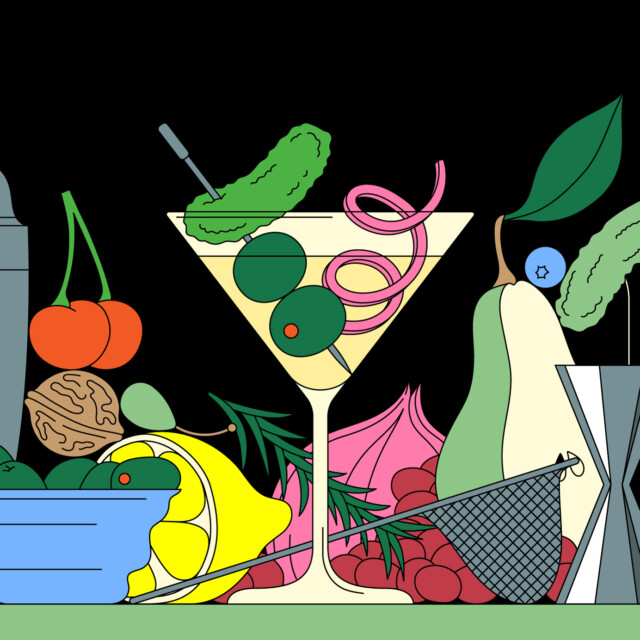Brian Evans, the director of bars at the restaurant group Sunday Hospitality, is not fazed by requests for Dirty Martinis. At Café Chelsea, the newest of the six bars he manages, 40 percent of all drink orders are Martinis and half of those are for Dirty Martinis. But, recently, an aberrant variation on that call gave him pause.
“What I’m seeing more than ever are Dirty Martinis with a twist,” he says. “That caught me off guard.” One can’t blame him. Dirty Martinis are all about the olive, both the fruit itself and its brine. Why throw the Martini’s rival garnish into the mix?
“If I was to make an assumption, people are trying to step their toe outside of the box into something that isn’t familiar,” says Evans.
Martini drinkers have always been particular. When they step up to the bar, it’s the beginning of a dance with the bartender, with many steps between the order and the delivered drink. Now, Dirty Martini drinkers want some of that action and are cutting in.
“I’ve noticed that guests are more specific on which spirit they’d like and how dirty they’d like their Martini,” says Stacey Swenson, beverage consultant at The Swan Room and Corner Bar in lower Manhattan. “I think it’s because guests have this idea that the Martini is customizable, and they feel special when they feel like they’ve personalized their order.”
But what is a personalized Dirty Martini order? Every bartender knows the rules to follow when fielding an order for a standard Martini: gin or vodka?; wet or dry?; up or on the rocks?; olive or twist?; etc. But as Joey Smith, beverage director of Chez Zou, points out, “there’s not a standard recipe for what a Dirty Martini is.” Nor is there an agreed-upon Dirty Martini vocabulary. Every call is a Dada poem recited on the fly from a barstool to a barkeep who may not fully grasp the poet’s meaning.
The first order of business — as it is with a regular Martini — is whether the customer wants vodka or gin. This step tends to separate the standard DM drinkers from the more exacting.
“I’d say the vodka Dirty Martini drinkers are still very broad,” says Marshall Minaya, bar director of Valerie, a gin-focused cocktail den in Manhattan’s Theater District. “They’re still very like, ‘I’ll have a Dirty Martini.’” Full stop. Gin Dirty Martinis drinkers often have a more particular cocktail in mind.
Next comes the brine levels. This is the equivalent of vermouth portions in a classic Martini, and just as important to the DM lover as vermouth is to the Martini maven. The standard terms in play are “dirty,” “extra dirty” and “filthy.” “Dirty” will generally get you a half ounce of brine. “Filthy” usually bumps that up to a full ounce. But the lexicon doesn’t end there. Steven Ferreira, a bartender at Bar Belly, has heard “Friday night dirty,” and Minaya has fielded orders for “extra filthy,” which results in equal parts spirit and brine.
“It’s ironic to go that far back to a 50/50 Martini with brine instead of vermouth,” he sighs.
Often, customers and bartenders differ on the finer meanings of “extra dirty” and other qualifiers. Chez Zou has devised a fix for this problem. Its Dirty Zou cocktail comes in a special glass jar with two chambers, one filled with the liquor, the other with brine. Customers can dirty up their drink to their exact liking. Swenson does something similar at The Swan Room, serving the olive brine on the side.
“This has resulted in speedier service, fewer drinks being sent back, and the guests typically really enjoy that they can customize their own dirty experience,” she says.
Then there’s the matter of garnish. As mentioned above, some DM drinkers are asking for a twist on top of their olives, or instead of olives. As for the olives, it’s a matter of how many. And one is never enough. “If you put down one olive,” said Minaya, “you’ll always hear ‘more olives, please.’”
There is also a new dirty cocktail on the block, the Dirty Gibson, in which a little onion brine, rather than olive brine, is added to the usual Gibson formula. At the Ivory Peacock, they even have a sub-zero Dirty Gibson on the menu. “We pickle our own onions and then batch the Dirty Gibson Martini with onion brine,” says head bartender Daniel Benitez. The drink is kept in the freezer until ordered.
Minaya finds the Dirty Gibson order concerning, noting that onion brine “is going to be much more acidic and vinegar forward” than olive brine. But, he admits, “if they’re coming in ordering a Martini like that, they know what they want.” (Gibson drinkers at The Swan Room get a Dirty Gibson whether they know it or not. The bar adds a bar spoon of onion brine to every Gibson. “No one has ever complained,” says Swenson.)
All of this is a lot of effort toward a cocktail that, more likely than not, is going to have one flavor note no matter how you make it. Do dissimilar Dirty Martini orders really produce markedly different-tasting cocktails, in the way that different Martini specs most certainly do? Opinions differ.
“Do I think more or less brine, vermouth, or any other modifier makes a difference? Absolutely,” says Ferreira. “I always invite a rather particular order when it comes to Dirty Martinis.”
Minaya, though, isn’t so sure. “To me, the brine is pretty overpowering,” he says.
Some bars, meanwhile, are doing the weird-Dirty-Martini-order work in advance, so their customers won’t have to. Bar Belly once offered a Walk of Shame Martini that was garnished with a cornichon, shallot, olive, and caper berry.
Even the most seasoned Dirty Martini drinker probably couldn’t have come up with that order.
